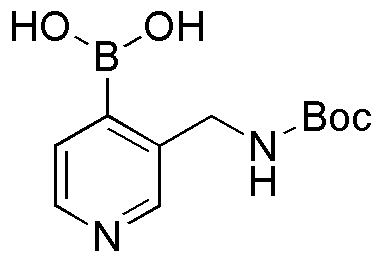3-(Boc-aminomethyl)pyridine-4-boronic acid is widely utilized in research focused on:
- Drug Development: This compound serves as a key intermediate in the synthesis of various pharmaceuticals, particularly in the development of targeted therapies for cancer treatment.
- Bioconjugation: It is employed in bioconjugation processes to attach biomolecules to surfaces or other molecules, enhancing the efficacy of drug delivery systems.
- Catalysis: The compound acts as a catalyst in organic reactions, improving reaction rates and selectivity, which is crucial in the production of fine chemicals.
- Material Science: It is used in the development of advanced materials, such as sensors and polymers, due to its unique boronic acid functionality that allows for specific interactions with sugars.
- Research in Medicinal Chemistry: This compound is a valuable tool for medicinal chemists exploring new drug candidates, particularly those targeting specific biological pathways.
General Information
Properties
Safety and Regulations
Applications
3-(Boc-aminomethyl)pyridine-4-boronic acid is widely utilized in research focused on:
- Drug Development: This compound serves as a key intermediate in the synthesis of various pharmaceuticals, particularly in the development of targeted therapies for cancer treatment.
- Bioconjugation: It is employed in bioconjugation processes to attach biomolecules to surfaces or other molecules, enhancing the efficacy of drug delivery systems.
- Catalysis: The compound acts as a catalyst in organic reactions, improving reaction rates and selectivity, which is crucial in the production of fine chemicals.
- Material Science: It is used in the development of advanced materials, such as sensors and polymers, due to its unique boronic acid functionality that allows for specific interactions with sugars.
- Research in Medicinal Chemistry: This compound is a valuable tool for medicinal chemists exploring new drug candidates, particularly those targeting specific biological pathways.
Documents
Safety Data Sheets (SDS)
The SDS provides comprehensive safety information on handling, storage, and disposal of the product.
Product Specification (PS)
The PS provides a comprehensive breakdown of the product’s properties, including chemical composition, physical state, purity, and storage requirements. It also details acceptable quality ranges and the product's intended applications.
Certificates of Analysis (COA)
Search for Certificates of Analysis (COA) by entering the products Lot Number. Lot and Batch Numbers can be found on a product’s label following the words ‘Lot’ or ‘Batch’.
*Catalog Number
*Lot Number
Certificates Of Origin (COO)
This COO confirms the country where the product was manufactured, and also details the materials and components used in it and whether it is derived from natural, synthetic, or other specific sources. This certificate may be required for customs, trade, and regulatory compliance.
*Catalog Number
*Lot Number
Safety Data Sheets (SDS)
The SDS provides comprehensive safety information on handling, storage, and disposal of the product.
DownloadProduct Specification (PS)
The PS provides a comprehensive breakdown of the product’s properties, including chemical composition, physical state, purity, and storage requirements. It also details acceptable quality ranges and the product's intended applications.
DownloadCertificates of Analysis (COA)
Search for Certificates of Analysis (COA) by entering the products Lot Number. Lot and Batch Numbers can be found on a product’s label following the words ‘Lot’ or ‘Batch’.
*Catalog Number
*Lot Number
Certificates Of Origin (COO)
This COO confirms the country where the product was manufactured, and also details the materials and components used in it and whether it is derived from natural, synthetic, or other specific sources. This certificate may be required for customs, trade, and regulatory compliance.


